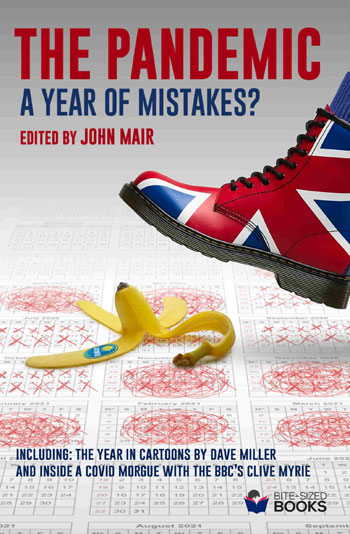
The media has had a crucial part to play in telling the story of the Covid-19 pandemic – a story that can be told about human tragedy and statistics.
The coronavirus pandemic is a human crisis that carries all the classic elements of the ultimate news story. It contains real danger, with lethal potential, requiring massive change in social habits and considerable economic and personal sacrifice. People are more reliant on experts than ever and are more concerned than at any other time about whether their leadership is up to the job.
Academic research and journalistic experience has long shown that a crisis, putting large numbers of people in danger, is a very newsworthy story boosting newspaper circulations and TV and radio viewers and listeners. Warning people of imminent danger raises circulation and informing people about how to avoid it, and what is being done to minimise it, continue to keep readership high.
The coronavirus pandemic is a human crisis that carries all the classic elements of the ultimate news story.
Rising newspaper home deliveries
Unfortunately for journalists and publishers, the Covid-19 pandemic was as damaging for national UK newspapers as it was for other business sectors. Circulations plunged by up to 20 per cent in March and April 2020 as people refused to visit their newsagent and switched to reading about the dangers online. Home deliveries rose, with more than 200,000 new customers signing up for home delivery, according to pressgazette.co.uk, whilst newspaper publishers reported large increases in unique online browsers.
The stories people wanted to read were about humanity, heroism and tragedy, stories often told in stark statistics describing how many infections, how many sick and how many dead – and more people than ever found they could access those stories online from sources reliable and otherwise.
All too often, the human tragedy of families losing grandparents, fathers, mothers, uncles or aunts and occasionally even young children was lost amidst a welter of numbers as the media tried to put the pandemic into context for its readers. For every death – well over 80,000 in the UK by January 2021 and rising – there are up to ten 18 to 49-year-olds suffering some form of ‘long’ Covid and as many as 22 over-70s.
With lockdown making the traditional reporting strategy of interviewing victims and their families difficult, the media tended to talk more about the numbers but journalists generally are not good at dealing with statistics. Many young people choose journalism because they enjoy writing and dealing with people, not because they enjoy figures or dealing with statistics and many actively avoid figures, which they find confusing. Too often the reporter or the sub-editor dealing with the story is unable to handle figures correctly or spot basic errors. It is a serious failing, as many government ministers and others use numbers to bamboozle the public through gullible journalists.
Too often the reporter or the sub-editor dealing with the story is unable to handle figures correctly or spot basic errors.
Big and far away
A Guardian story covering the conjunction of Saturn and Jupiter on 21 December 2020, for instance, reported that Jupiter was only 886,000km from earth rather than the 886m km that it actually was at the time. This highlights the problem that many journalists face of not grasping whether a number is too small or too large. Had those editing the column in the Guardian (it was removed very shortly after publication) thought it through they may have considered that our moon is already about half that distance from earth.
Scale is important as Michael Blastland and Andrew Dilnot emphasise in their excellent book, The Tiger that Isn’t: Seeing Through a World of Numbers (Profile, 2007). They advise would-be journalists to consider ‘Is this a large number?’ – useful advice when government ministers often claim to be solving a problem by supplying a ‘large’ injection of cash.
Unfortunately, the ineptitude, or certainly inexperience, of many journalists with using and analysing data has proved to be a problem when informing people about a pandemic which is mainly being told in numbers. This is especially true when a number of commentators seem determined to minimise the threat posed by the pandemic.
False or misleading claims are often made by columnists and it is impossible to know if they just have the same difficulty understanding and manipulating figures that many other journalists do or if they are simply selecting data that suits their own agenda. Figures are plucked, seemingly from nowhere, as sources are rarely provided. Allison Pearson, for instance, tweeted on 29 December 2020 that: ‘National hospital bed occupancy is currently 85 per cent ... bed occupancy for this quarter last year [2019] was 92 per cent.’
This implied that claims by the NHS of a threat to being overwhelmed were at least exaggerated. However, NHS England data shows a total bed occupancy rate for October to December 2019 of 85 per cent. NHS England has yet to publish the equivalent 2020/21 data but it did announce in December that it was clearing all beds of any patient who could be discharged and was reducing elective surgery. By 3 December, 113,058 beds out of a total of 118,451 (95.4 per cent) were full, 12,896 of them with Covid-19 patients suggesting Pearson may have got her figures confused. This data is for England only and Pearson does not specify to which nation she is referring, but Scotland, Wales and Northern Ireland are unlikely to alter the figures significantly.
Pearson is not the only commentator to struggle with figures. Another example of statistics abuse came in the Daily Mail and drew stinging criticism from Neil O’Brien, the Conservative MP for Harborough, when it published a graph by a so-called ‘Statistics Guy’ claiming to show that excess deaths in the UK were barely higher than the average over the past five years.
O’Brien tweeted: ‘The first clue as to what is going on is that the “Statistics Guy” turns out to be a cranky Covid-denial Twitter feed, run by a guy with a cartoon avatar.’ O’Brien went on to point out that the graph was ‘adjusted for population growth’. And he calculated that the ‘Statistics Guy’ had adjusted for a population growth of 6.8 per cent, impossibly high. The ONS estimate is less than a tenth of that. The Daily Mail later amended the graph.
There are several divides in society that are emphasised by the virus and the statistics that underpin it.
Dividing society – Us and Them
The Daily Mail has been one of a number of newspapers that are keen to play down the pandemic. Journalists trying to tell the story of the ebb and flow of Covid-19 have found it difficult to present meaningful statistics. For a start, they show a number of societal divides that pay dividends to newspaper and journalist who find that dividing society into ‘them’ and ‘us’ sells more newspapers. There are several divides in society that are emphasised by the virus and the statistics that underpin it.
First, the young. Those below 50 are seemingly not badly affected by the virus with only 1,452 (1.9 per cent) deaths in England and Wales compared with 76,669 overall, according to ONS data at 18 December 2020. Only 16 per cent of those aged under 70 die and children are even less affected.
There is also a divide between north and south. This has become more heavily emphasised for those living in the south because of the migratory nature of the virus moving north then back south and then back north again. The north has long been aware of the southern, London-centric nature of the news but the virus has really highlighted this for both groups.
A further divide is that between rich and poor. The rich use their wealth as a cushion to keep them safer than those obliged to go out to work and then return to crowded homes with no ability to isolate.
There is also a clear divide between white and black with death rates amongst black and minority ethnic groups up to four times higher than white communities, something shown by the large number of BAME health workers who have died. A British Medical Journal article identified that, after the first wave in April 2020, 63 per cent of healthcare workers who died were from a BAME background.
Finally, there is a divide between men and women with 59.3 per cent of all Covid-19 deaths under the age of 80 being men. Women only start to catch up in their nineties when the balance is reversed mainly because fewer men live into their nineties.
Using statistics to emphasise divides is a favourite tool of the commentator to split their readership into ‘them’ and ‘us’. Crudely put, speaking to those who are reasonably well off, white and able to work from home, it is easy to suggest that fear of the virus is being used to protect a few at the expense of the economy. A controversial, outspoken viewpoint is a style of journalism that relies less on facts and more on sensation. Claiming that the virus is being exaggerated and that lockdown is the bigger danger is an easy way to do that ignoring the fact that it is the virus that disrupts economic activity. People tend to stay home when infection rates are high for their own safety, not because they have been instructed to.
Continual, half-hearted lockdowns are simply a failure of government policy. We either let the virus infect all in its path with the risk of a rapidly escalating death toll, wide-spread sickness, an over-whelmed NHS and the potential for virus mutation to something even more deadly or alongside the rapid deployment of the vaccine, we plan a proper virus elimination programme with foreign travel quarantine and ruthless track and trace even if that does require a short lockdown to rapidly reduce the cases already allowed to spiral out of control.
Using statistics to emphasise divides is a favourite tool of the commentator to split their readership into ‘them’ and ‘us’.

This article was first published in ‘The Pandemic – A Year of Mistakes?’, edited by John Mair and published by Bite-Sized Books.












